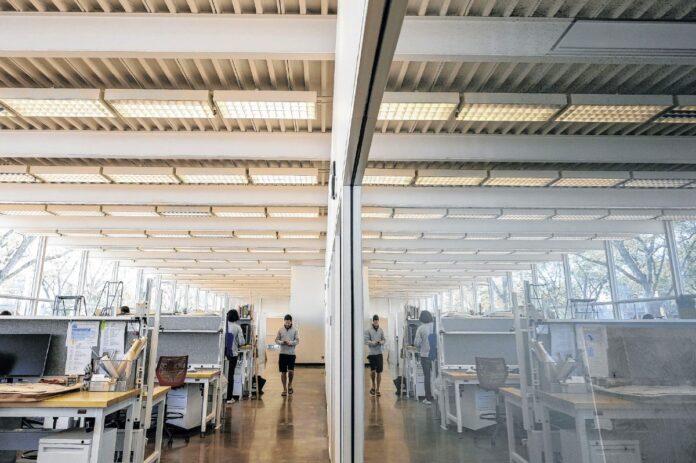
Outside the Second Street entrance of the building that houses Indiana University’s master’s program for architecture stands a white plastic panel and steel frame passageway, called “Entry Portal.”
While it is one of the temporary installations on display for Exhibit Columbus, a months-long exhibition that highlights the city’s art, architecture and design heritage, it also provides a symbolic connection between the second-year J. Irwin Miller Architecture Program and its host city.
However, there’s nothing symbolic about the interaction between the program’s faculty and students with the city and its residents. According to local arts and education leaders, it’s been a firm embrace by both parties that has benefited the Columbus community and helped the architecture program gain solid footing and grow.
Growing connection
[sc:text-divider text-divider-title=”Story continues below gallery” ]Click here to purchase photos from this gallery
“From the (Columbus Area) Arts Council’s perspective, this is something we’re excited to have because it adds another cultural asset,” said Kathryn Armstrong, the arts council’s executive director.
The arts bring in money and support downtown development, and communities should want creative people because they help make communities interesting and unique, she added.
“They (Indiana University) bring in amazing talent and faculty and staff, and it adds to the creative community,” Armstrong said.
Exhibit Columbus is one such example.
“Entry Portal” was designed by Daniel Luis Martinez and Etien Santiago, both assistant professors with the J. Irwin Miller Architecture Program. They are University Design Research Fellows with this year’s exhibition. The fellowships “highlight current research by leading professors of architecture and design working at public institutions in the Heartland,” according to the Exhibit Columbus website.
Richard McCoy, the managing director of the Exhibit Columbus team, described “Entry Portal” as a remarkable contribution.
“It elegantly welcomes visitors to their iconic building to view their program and at the same time invites the students to explore all that makes this place so special. This gesture seems to symbolize the potential that the program holds.”
That potential has been seen on other ways, too.
Martinez, an architectural designer, and his wife Lulu Loquidis, a landscape architect, founded the Columbus-based LAA Office, a studio that blends, landscape, art and architecture in projects.
Martinez and Loquidis also created and installed a mural for the east facade of the 411 gallery building on Sixth Street as part of their Columbus Area Arts Council design residency. And, the couple reinterpreted historic design drawings into contemporary, public artwork for a public exhibit celebrating the 50th anniversary of the Cleo Rogers Memorial Library, which was designed by renowned architect I.M. Pei.
Faculty also have taken on roles to help local organizations. For example, T. Kelly Wilson, the director of the J. Irwin Miller Architecture Program, serves on the Columbus Area Arts Council’s board. Britt Brewer, the architecture program’s community outreach coordinator, provides custom tours for university architecture groups, said Karen Niverson, executive director of the Columbus Area Visitors Center.
The public also has been able to learn a bit more about the architecture program’s faculty and staff through exhibitions of their work at the program’s public gallery in the Republic Building, the former newspaper building at 333 Second St. that was designed by Myron Goldsmith. The second such exhibit was Feb. 15 through March 29.
“I’m excited to see how the program is unfolding, and how the faculty, staff and students are connecting with and becoming a part of the community,” said John Burnett, president and CEO of the Columbus-based Community Education Coalition.
Starting in 2015, the CEC worked with Indiana University for several years to gain university and state approval for the master’s program in Columbus, in an effort to expand higher education here, further utilize the city’s more than 65 examples of Modern architecture and build on its reputation for architecture.
Wilson noted that even before the first students arrived on campus the program received inquiries from the community for assistance with projects. That’s provided the students with some good opportunities for hands-on learning that benefits others.
For example, for Cummins Inc.’s renovation of its Corporate Office Building, it asked the architecture program to help with redesigns of 90 meeting rooms. The project is creating wall reliefs for each room, Wilson said.
The J. Irwin Miller Architecture program received 30 applications for its first cohort, and 22 students arrived for the start of the program in August 2018. The program received 27 applications for the second cohort, and 16 students arrived for this fall term, Wilson said.
Both cohorts represent a diversity of backgrounds, genders, races and ethnicities, and the rate of students joining the new program based on applications is very pleasing, Wilson said.
“The average when I served on admissions at both Harvard and Yale was a 50% yield from the number of students that had been accepted. I think our unusually high yield rate may be due to the uniqueness of our program and that these students want to be part of something new,” Wilson said.
Wilson said he regularly attends graduate fairs at colleges to share information about the master’s program in architecture, and the program regularly receives inquiries from curious students — including some from foreign countries.
Unique experience
The program emphasizes art and architecture because they come from the same root, Wilson told a handful of prospective master’s students who attended an open house Sept. 19 at the Republic Building, in order to learn more about the program.
Understanding the relationship between the two “gives you your own voice in creating architecture,” Wilson told the open house guests.
This emphasis makes IU’s program different from other programs, Wilson said. Its Nomadic Studio, which allows students to study abroad, also makes the program special, Wilson said.
The first cohort spent three weeks in Rome after the spring term, where they sketched and analyzed famous buildings such as the Pantheon. The Nomadic Studio is an opportunity for students to apply what they’ve learned from famous building to future projects, Wilson told the prospective students.
“I don’t go to the Pantheon to see how it was built. I go there to steal (ideas) from it,” he said.
Mexico City, Chicago, Berlin and Bangkok are among future locations being considered for study abroad, Wilson said.
Albert Bracken, 29, of Indianapolis, said he attended the open house because he’s dreamed of being an architect since he was a child. After earning a bachelor’s degree in psychology, an aborted attempt at an undergraduate degree in architecture, a photography career and earning a master’s degree in urban design, Bracken said he wants to realize his dream.
IU’s master’s program interests Bracken, he said, because he’s looking for a different school and different educational experience. His undergraduate degrees are from Ball State University, and Bracken was in its undergraduate architecture program briefly.
“I want to stay in state and IU has a great reputation, even though its architecture courses are new,” Bracken said.
Bracken said he learned about IU’s program from a friend at Ball State who had attended IU. He attended the open house to learn more about the experience, the skills he’d learn in the program and how it would prepare him for job placement.
Current students who met with the open house guests over lunch explained that many of the students enter the program with no architectural background, but quickly learn technical programs and other essential skills through workshops and the generous guidance of the professors.
Victoria Bell, however, is one of a handful of students who earned undergraduate degrees in architecture before joining IU’s program.
Bell, 23, is a 2014 Columbus East High School graduate and a 2018 Ball State graduate. The opportunity to join a new program that’s in her hometown was appealing.
One thing she’s enjoyed is the opportunity to get hands-on experience early.
Bell and a few other students who had architecture degrees didn’t have to take a structures class and were allowed to pursue an independent project. One they worked on was with St. Paul’s Episcopal Church, located on California Street.
Three trees on an island area in the church’s parking lot had to be cut down. The island is right across the front entrance to the church, and the church wanted to come up with a new use for the island space.
Bell, who attends St. Paul’s, brought the architecture program and church together to collaborate. What the students designed was a swooping A-frame structure with a large cross beside it that invites people to the church. It’s called the “St. Paul’s Prayer Terrace.” The designs are ready so if the church wanted to move forward with the project they could give them to a builder, Bell said.
“It was special to me,” Bell said of the project.
Niverson said that kind of energy and activity from the students adds vibrancy and added context to the community and the Republic Building, one of the stops on the Visitors Center’s architectural tour.
But it’s seen and appreciated elsewhere, too.
“Just seeing the students on the library plaza painting, or encountering students at a downtown event brings a youthful element to our community,” Niverson added.
[sc:pullout-title pullout-title=”About the program” ][sc:pullout-text-begin]
What: Indiana University’s J. Irwin Miller Architecture Program, a three-year master’s degree program, offered through the Eskenazi School of Art, Architecture + Design.
Location: 333 Second St., Columbus. Program’s building is the former home of The Republic, which the newspaper occupied from 1971 through December 2016. The all-glass building was designed by renowned American architect Myron Goldsmith, of the Chicago-based firm Skidmore, Owings & Merrill. The building was designated a National Historic Landmark in 2012.
Highlights:
- Open to students coming from different disciplines
- Utilizes Columbus’ more than 65 examples of Modern architecture, its size, its fabrication technology at local manufacturing companies and its coalition-building process
- Has study abroad component for students
- Involves hands-on learning that would include building projects that aid and support the Columbus community’s interests
- Students will learn how to become entrepreneurs and community contributors
[sc:pullout-text-end][sc:pullout-title pullout-title=”To learn more” ][sc:pullout-text-begin]
To learn more about Indiana University’s J. Irwin Miller Architecture program, go online at architecture.indiana.edu.
[sc:pullout-text-end][sc:pullout-title pullout-title=”Hale vignette” ][sc:pullout-text-begin]
When IU began offering its master’s program in architecture in Columbus, Grant Hale was excited to add that to his list of experiences. The 42-year-old Columbus resident has a varied background that includes:
- Working as a field program officer for the United States Agency for International Development along the Afghanistan/Pakistan border, where he worked with relief agencies on development projects
- Working for Cummins Inc. in international distribution
- Being a stay-at-home dad and raising two children
"I want to use everything I learn in this program and pour it back into the community of Columbus," he said.
[sc:pullout-text-end][sc:pullout-title pullout-title=”Hanamura vignette” ][sc:pullout-text-begin]
First-year-student Hiroko Hanamura, 27, of Tokyo, said she earned an undergraduate degree in music and studied interior design for two years at IU. She enjoyed the sketches she created in her interior design classes, and combined with encouragement from professors reached an "Ah ha!" moment.
After Hanamura learned about new architecture program, T. Kelly Wilson, director of IU’s architecture school, came to Bloomington to meet with her.
"He told me his vision about combining art and architecture, just like it used to be in the old days," she said.
[sc:pullout-text-end][sc:pullout-title pullout-title=”Dimond vignette” ][sc:pullout-text-begin]
Second-year student Patrick Dimond, 26, of Indianapolis, studied communications and worked for Ratio Architects in Indianapolis as a marketing coordinator for two years. Being in that setting influenced him to pursue a degree in architecture.
IU’s program attracted him because it was "new and it was malleable," and it included a visual studies component.
The malleable aspect allows students to contribute ideas, Dimond said. For instance, Dimond said he and some other students have pursued the idea of a design project that could "aid the community in some way," and possibly be part of the curriculum.
"I have to applaud it," said T. Kelly Wilson, director of the architecture program.
[sc:pullout-text-end]




